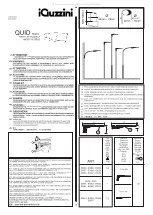
PART NO.
IMAGE
DESCRIPTION
QTY
ACHUPS
Photocell/Daylight harvesting Sensor,1-10Vdc Dim
down/up according to ambient brightness level,
target light level adjustable. Ip20 rated.
1
ACHUPS-MB
Mounting Bracket for the ACHUPS
Photocell Sensor
1
10-00032
#4-40 Pan Head Machine Screw
2
10-00033
#4-40 Hex Nut
2
USHIBAYRxxxWPL (300W-480W) Series LED Highbays Installation Guide
DAYLIGHT HARVESTING SENSOR
INSTALLATION STEPS
V(-)
[BLACK]
V(+)
[RED]
TO LOAD
[LED BOARD]
[WHITE]
RED (+)
BLACK (-)
DIMMING
INPUT
NEUTRAL [WHITE]
LINE [BLACK]
ACL
(BLACK)
ACN (WHITE)
CONNECTION TO (DAYLIGHT
HARVESTING SENSOR
ACHUPS)
[BLACK]
DIMMABLE LED DRIVER
AC POWER
SUPPLY
GRAY (-)
PURPLE (+)
ACHUPS-MB
1) Remove the two [2] #4-40 PHMS from the mounting bracket.
Using a Phillips screw driver (preferable with a magnetic tip), Fasten
the bracket onto the FHW luminaire (all fixtures have two small
holes specifically made for the ACHUPS-MB bracket and use the
hexnuts provided to lock it in place.
2) Refer to the wiring diagram to connect the ACHUPS to the
Dimmable LED Driver.
3) Make sure all wiring connections are made inside a J-Box. Since
the Daylight Harvesting Sensor is to only be used indoors. It must
be an Indoor J-Box.
ACHUPS
10-00032
10-00033
Inside J-Box ( Not Included)
4) On the photocell, there is a small
adjustable knob with a (+) and (-) sign,
this knob is the Potentiometer for
adjusting the light level desired. It is
recommended for the target light level
to be between 40% to 80% of the total
lux of luminaires.
CAUTION:
PLEASE FOLLOW THIS INSTRUCTION MANUAL
CAREFULLY TO PREVENT ANY INJURIES OR
COMPLICATIONS THAT MAY ARISE.
WARNING:
Before installing or maintaining the luminaire, make sure all powers
are
TURNED OFF
. Verify that the supply voltage is correct by comparing it with
the label information on all fixtures. Make all connections in accordance with the
NEC requirements, and make sure all luminaries are properly secured to prevent
any wire complications. This luminaire is not to exceed the maximum ambient
temperature rating noted on the specification sheet.


























